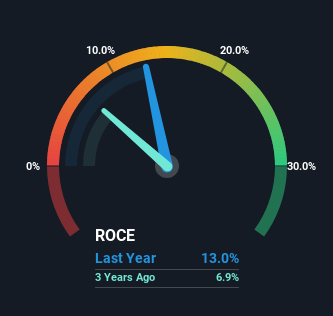- Hong Kong
- /
- Electronic Equipment and Components
- /
- SEHK:1723
Here's What's Concerning About HK Asia Holdings' (HKG:1723) Returns On Capital
When it comes to investing, there are some useful financial metrics that can warn us when a business is potentially in trouble. When we see a declining return on capital employed (ROCE) in conjunction with a declining base of capital employed, that's often how a mature business shows signs of aging. This indicates the company is producing less profit from its investments and its total assets are decreasing. On that note, looking into HK Asia Holdings (HKG:1723), we weren't too upbeat about how things were going.
Return On Capital Employed (ROCE): What Is It?
For those who don't know, ROCE is a measure of a company's yearly pre-tax profit (its return), relative to the capital employed in the business. The formula for this calculation on HK Asia Holdings is:
Return on Capital Employed = Earnings Before Interest and Tax (EBIT) ÷ (Total Assets - Current Liabilities)
0.13 = HK$16m ÷ (HK$139m - HK$13m) (Based on the trailing twelve months to March 2024).
So, HK Asia Holdings has an ROCE of 13%. On its own, that's a standard return, however it's much better than the 7.4% generated by the Electronic industry.
View our latest analysis for HK Asia Holdings

Historical performance is a great place to start when researching a stock so above you can see the gauge for HK Asia Holdings' ROCE against it's prior returns. If you'd like to look at how HK Asia Holdings has performed in the past in other metrics, you can view this free graph of HK Asia Holdings' past earnings, revenue and cash flow.
What Does the ROCE Trend For HK Asia Holdings Tell Us?
There is reason to be cautious about HK Asia Holdings, given the returns are trending downwards. To be more specific, the ROCE was 23% five years ago, but since then it has dropped noticeably. Meanwhile, capital employed in the business has stayed roughly the flat over the period. Since returns are falling and the business has the same amount of assets employed, this can suggest it's a mature business that hasn't had much growth in the last five years. If these trends continue, we wouldn't expect HK Asia Holdings to turn into a multi-bagger.
The Bottom Line
In summary, it's unfortunate that HK Asia Holdings is generating lower returns from the same amount of capital. We expect this has contributed to the stock plummeting 84% during the last five years. That being the case, unless the underlying trends revert to a more positive trajectory, we'd consider looking elsewhere.
HK Asia Holdings does have some risks, we noticed 2 warning signs (and 1 which is significant) we think you should know about.
While HK Asia Holdings may not currently earn the highest returns, we've compiled a list of companies that currently earn more than 25% return on equity. Check out this free list here.
New: Manage All Your Stock Portfolios in One Place
We've created the ultimate portfolio companion for stock investors, and it's free.
• Connect an unlimited number of Portfolios and see your total in one currency
• Be alerted to new Warning Signs or Risks via email or mobile
• Track the Fair Value of your stocks
Have feedback on this article? Concerned about the content? Get in touch with us directly. Alternatively, email editorial-team (at) simplywallst.com.
This article by Simply Wall St is general in nature. We provide commentary based on historical data and analyst forecasts only using an unbiased methodology and our articles are not intended to be financial advice. It does not constitute a recommendation to buy or sell any stock, and does not take account of your objectives, or your financial situation. We aim to bring you long-term focused analysis driven by fundamental data. Note that our analysis may not factor in the latest price-sensitive company announcements or qualitative material. Simply Wall St has no position in any stocks mentioned.
About SEHK:1723
Moon
An investment holding company, engages in the wholesale and retail sale of the pre-paid products in Hong Kong.
Flawless balance sheet with low risk.
Market Insights
Community Narratives


Recently Updated Narratives


Engineered for Stability. Positioned for Growth.


MINISO's fair value is projected at 26.69 with an anticipated PE ratio shift of 20x


Fiverr International will transform the freelance industry with AI-powered growth
Popular Narratives


MicroVision will explode future revenue by 380.37% with a vision towards success


NVDA: Expanding AI Demand Will Drive Major Data Center Investments Through 2026



